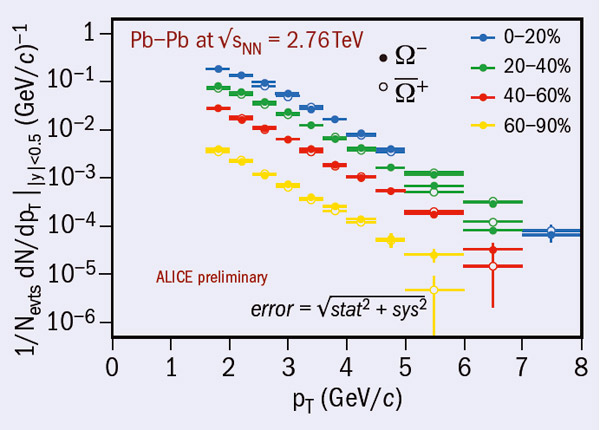
The ALICE collaboration has measured the production of baryons containing two or three strange quarks in lead–lead collisions at the LHC, at an energy of 2.76 TeV per nucleon pair, nearly 14 times larger than that obtained previously at Brookhaven’s Relativistic Heavy Ion Collider (RHIC). The yields and transverse-momentum spectra of multi-strange baryons and antibaryons in heavy-ion collisions are important in characterizing the evolution of the hot-matter created, as it passes from the strange quarks and antiquarks of the early partonic stages to the subsequent hadronization.
The collaboration identified multi-strange baryons mainly by a topological method, looking for their weak-decay products originating from secondary vertices well separated from the main interaction vertex. The researchers also exploited particle identification via specific energy loss in the time projection chamber (TPC). For example, the Ω– baryon (consisting of three strange quarks) decays into a negative K meson and a neutral Λ baryon, which in turn decays into a proton and a negative π meson. A peak in the invariant mass spectrum of all (Λ, K–) combinations provides a clearly identifiable signal (figure 1).
Good momentum resolution and a precise secondary-vertex reconstruction were essential for this result. A key element was the excellent performance of the main tracking detectors in ALICE’s central barrel – the TPC and the internal tracking system (ITS) – in the challenging environment of central (head-on) lead–lead collisions.

The data were analysed in transverse momentum intervals up to 6–9 GeV/c for the doubly-strange baryons (Ξ– and charge conjugate separately) and 6–8 GeV/c for the triply-strange baryons (Ω– and charge conjugate separately), made possible by the examination of 30 million minimum-bias nuclear interaction candidate events. In addition, the centrality of the selected events was determined from signals collected in two scintillator hodoscopes at backward and forward rapidities (K Aamodt et al. 2011). This allowed the analysis to be repeated in four different centrality intervals, from the 0–20% most central (almost head-on) collisions to the 60–90% peripheral collisions, in order to compare with previous results at RHIC. Figure 2 shows the resulting transverse-momentum spectra, fully corrected for detector acceptance and efficiency; it also shows clearly how multi-strange baryon production increases with the centrality of the collision at LHC energy. The results were presented at the recent conference on Strangeness in Quark Matter (Strangeness and heavy flavours in Krakow).
Previous experiments at CERN’s Super Proton Synchrotron (SPS) and at RHIC obtained multi-strange baryon spectra and yields in 17 GeV lead–lead and 200 GeV gold–gold collisions, respectively. The ALICE experiment not only finds higher yields in lead–lead collisions at the LHC energy, but also finds that the enhancement with respect to proton–proton collisions is greater for the Ω than for the Ξ, confirming the trend observed at both SPS and RHIC. Moreover, the enhancement with respect to proton–proton data increases with the centrality of the collision, in a similar way to previous observations.
Further reading
For more information, see ALICE contributions to SQM 2011 at http://indico.ujk.edu.pl/conferenceTimeTable.py?confId=0.
K Aamodt et al. (ALICE collaboration) 2011 Phys. Rev. Lett. 106 032301.







